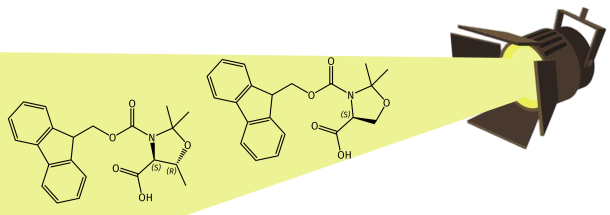Welcome to Iris Biotech
For better service please confirm your country and language we detected.

For better service please confirm your country and language we detected.

Thank you very much for your interest in our products. All prices listed on our website are ex-works, Germany, and may attract customs duties when imported.
You may/will be contacted by the shipping company for additional documentation that may be required by the US Customs for clearance.
We offer you the convenience of buying through a local partner, Peptide Solutions LLC who can import the shipment as well as prepay the customs duties and brokerage on your behalf and provide the convenience of a domestic sale.
Continue to Iris Biotech GmbHSend request to US distributorPublished on 16/11/2021

Pseudoprolines derived from Serine, Threonine and Cysteine gained broad attention as “preventors” of peptide aggregation during solid-phase peptide synthesis. Within those building blocks, the Serine or Threonine residue is reversible protected as a proline-like 4-carboxyoxazolidine. As the formed oxazolidine rings are labile to TFA, the native sequence can be regenerated during cleavage and global deprotection. In analogy to Prolines, Pseudoprolines impose a kink on the peptide chain by favoring the cis- over the trans-amide bond formation. This disrupts the generation of beta-sheet secondary structures, which are considered as a source of aggregation during chain elongation, thus serving as solubilizing building blocks.
Typically, pseudoprolines are incorporated as dipeptides as the corresponding monomers were reported to exhibit low coupling efficiencies. However, only a limited number of combinations of such dipeptides are commercially available. In principle, at least 60 different pseudoproline dipeptides are required to cover the combination of Ser/Thr/Cys with each of the 20 natural amino acids.
Based on advances in peptide synthesis, such as modern coupling reagents and protocols, Senko et al. reported the incorporation of Fmoc-protected pseudoproline monomers. Different acylation protocols and peptides were tested to confirm the efficacy of those building blocks.
More specifically, the following six different activation methods for the coupling of the pseudoproline monomer were tested: DIC/HOAt, DIC/HOBt, BOP/DIPEA, HATU/DIPEA, TFFH/DIPEA, symmetrical anhydrides. Acylation efficacies were determined by HPLC analysis of the crude peptide mixtures. All acylation methods except for BOP/DIPEA worked. As typically expected, the results showed that the acylation of some amino acids is more effective than others. For example, amino acids with small aliphatic side chains and/or small side-protecting groups such as Ala, Leu, Asp/Glu, Ser, Thr were coupled more efficiently than amino acids with aromatic side chains or bulky side-protecting groups such as Phe, Trp, Arg, His, Asn/Gln. For detailed results, please see Amino Acids 2021; 53: 665-671.
Iris Biotech provides the Fmoc-protected Serine- and Threonine-based pseudoproline as monomer for solid-phase peptide synthesis avoiding the requirement for pseudoproline dipeptides giving the possibility to introduce pseudoprolines in peptides containing non-natural or rare amino acids.
References:
Scope and limitations of pseudoprolines as individual amino acids in peptide synthesis; D. A. Senko, N. D. Timofeev, I. E. Kasheverov, I. A. Ivanov; Amino Acids 2021; 53: 665-671. https://doi.org/10.1007/s00726-021-02973-1.
Pseudo-Prolines as a Molecular Hinge: Reversible Induction of cis Amide Bonds into Peptide Backbones; P. Dumy, M. Keller, D. E. Ryan, B. Rohwedder, T. Wöhr and M. Mutter; J. Am. Chem. Soc. 1997; 119: 918-925. https://doi.org/10.1021/ja962780a.
Pseudo-Prolines as a Solubilizing, Structure-Disrupting Protection Technique in Peptide Synthesis; T. Wöhr, F. Wahl, A. Nefzi, B. Rohwedder, T. Sato, X. Sun and M. Mutter; J. Am. Chem. Soc. 1996; 118: 9218-9227. https://doi.org/10.1021/ja961509q.
Expediting the Fmoc solid phase synthesis of long peptides through the application of dimethyloxazolidine dipeptides; P. White, J. W. Keyte, K. Bailey and G. Bloomberg; J. Pept. Sci. 2004; 10: 18-26. https://doi.org/10.1002/psc.484.
Pseudoprolines as Removable Turn Inducers: Tools for the Cyclization of Small Peptides; D. Skropeta, K. A. Jolliffe, and P. Turner; J. Org. Chem. 2004; 69: 8804-8809. https://doi.org/10.1021/jo0484732.